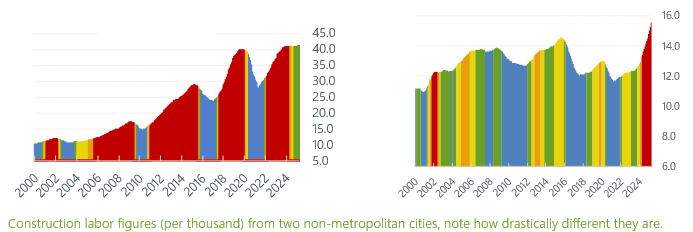Despite advances in project planning, many in the industry continue to rely on a "2D" estimating model, a static calculation of rates and quantities. Vermeulens has demonstrated to owners, architects, and institutions that the cost-per-square-foot model needs to be viewed through an economic filter in today’s rapidly changing construction landscape. Successful cost management requires a dynamic approach that reflects real-time market forces.
Driven by nationwide growth, construction is rapidly expanding into secondary and emerging markets beyond major hubs like Dallas and Austin.
Take a rapidly growing remote city 200 miles from a major metropolitan and inject a $2 billion bond program into a construction market with near full employment and high wages. In markets like these, attracting contractors becomes the top priority. Estimating must account for real-time local conditions such as labor availability, material volatility, contractor capacity, and economic pressures.
Subcontractors often evaluate projects using a “risk ratio,” which measures how much fee and material markup they have available to manage labor-related risks such as availability and productivity. Early procurement, alternates, and owner direct purchases can all influence this ratio, sometimes favorably, but in high labor risk regions, they can also push the risk ratio too far. If it climbs too high, subcontractors may choose not to bid at all, or if they do, it will be at a higher than typical margin.
This is why adopting a Dynamic Market Estimating (DME) approach is crucial. It adds a critical third dimension to the cost model: Real-Time Market-Specific Conditions. Rather than relying on averages, DME tailors every project to the current realities at the moment the project is conceived.
Additionally, some higher education institutions located in remote or secondary markets require additional contingency for projects over a certain size, often $50 million or more. This is due to limited local labor capacity, which necessitates importing skilled workers and drives up costs for per diem, lodging, and logistics. That reality, coupled with understanding how institutional specifications and design standards impact pricing, highlights why a fixed contingency percentage is often insufficient. As labor conditions and institutional requirements evolve, contingency strategies must be regularly updated to reflect current market dynamics rather than outdated assumptions.
The Dynamic Market Estimating approach offers several advantages:
- better risk management: accounts for vulnerabilities specific to each project location
- more accurate budgets: avoids one-size-fits-all assumptions that lead to costly surprises
- real value for owners: transparent, tailored estimates build trust and ensure funding confidence
- adaptability: allows budgets to adjust dynamically as market conditions evolve
DME is the only way to deliver reliable, market-responsive budgets that reflect real-world complexities. Traditional "2D" estimating is no longer sufficient.
Hiring an experienced cost consultant, one who tracks hundreds of projects annually and stays fully attuned to market shifts, is critical to successful project delivery.






